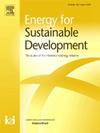在尼泊尔接受和持续使用预制生物消化池
IF 4.9
2区 工程技术
Q2 ENERGY & FUELS
引用次数: 0
摘要
沼气是一种很有前途的清洁烹饪替代品,它已经在尼泊尔使用了几十年。然而,由于气温较低,在寒冷的月份,它们的表现往往会下降。这项研究有三个主要目标:(i)评估隔热对沼气生产能力的影响,(ii)评估用户接受程度和继续使用沼气池模型的意愿,(iii)估计家庭的经济效益。在尼泊尔的四个地区安装了22个浮动消化池,覆盖丘陵和德莱地区。每个蒸煮器都是用三种绝缘类型中的一种制造的:无绝缘、中绝缘或全绝缘。通过比较不同保温类型的产气量来评估沼气池的性能,通过结构化调查和技术接受模型(TAM)来评估用户继续使用的意愿,通过避免液化石油气(LPG)消耗和投资回收期分析来衡量经济效益。结果表明,完全隔热效果最好,特别是在冬季的丘陵地区,在那里,完全隔热的沼气池比非隔热的沼气池平均多产生47%的气体,冬季产量增加了253%。值得注意的是,由于维护问题、制造缺陷和用户忽视,只有不到一半的消化器保持功能。TAM分析显示,用户继续使用的意图受到感知有用性和感知信任的支持。经济分析显示,投资回收期由1.3年至15年不等,主要原因是更换石油气的程度不同。该研究建议制造商提高部件的耐用性和质量,并要求用户对定期维护负责。沼气计划应侧重于确定愿意长期接受沼气厂的忠实用户,确保沼气成功融入清洁烹饪过渡。本文章由计算机程序翻译,如有差异,请以英文原文为准。
Acceptance and the sustained use of prefabricated biodigesters in Nepal
Biogas is one of the promising clean cooking alternatives, it has been used in Nepal for decades. However, performance often declines during colder months due to low temperatures. This study had three main objectives: (i) to assess the impact of insulation on biogas production capacity, (ii) to evaluate user acceptance and intention to continue using biodigester models, and (iii) to estimate the economic benefits for households. Twenty-two floating digesters were installed in four districts of Nepal, covering the Hilly and Terai regions. Each of the digesters was fabricated with one of the three insulation types: none, medium, or full. Digester performance was evaluated by comparing gas yield across insulation types, user intention to continue usage was assessed using structured surveys and the Technology Acceptance Model (TAM), and economic benefits were measured through avoided liquid petroleum gas (LPG) consumption and payback period analysis. Results showed that full insulation performed best, particularly in the hilly region during winter, where fully insulated digesters produced 47 % more gas on average than non-insulated units, with winter production increasing by up to 253 %. Notably, fewer than half of the digesters remained functional because of maintenance issues, manufacturing defects, and user neglect. TAM analysis revealed that user intent for continued usage was supported by Perceived Usefulness and Perceived Trust. Economic analysis revealed varying payback periods of 1.3 to 15 years, with the variation explained mainly by differences in the extent of LPG replacement. The study recommends that manufacturers increase the durability and quality of components and that users be held accountable for regular maintenance. The biogas program should focus on identifying committed users willing to accept biogas plants in the long term, ensuring the successful integration of biogas into the clean cooking transition.
求助全文
通过发布文献求助,成功后即可免费获取论文全文。
去求助
来源期刊

Energy for Sustainable Development
ENERGY & FUELS-ENERGY & FUELS
CiteScore
8.10
自引率
9.10%
发文量
187
审稿时长
6-12 weeks
期刊介绍:
Published on behalf of the International Energy Initiative, Energy for Sustainable Development is the journal for decision makers, managers, consultants, policy makers, planners and researchers in both government and non-government organizations. It publishes original research and reviews about energy in developing countries, sustainable development, energy resources, technologies, policies and interactions.
 求助内容:
求助内容: 应助结果提醒方式:
应助结果提醒方式:


